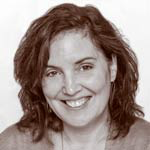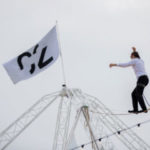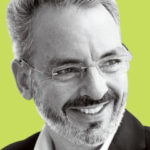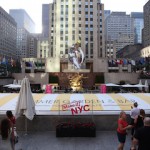
During morning rush hour on Friday, May 30, drivers whizzing across the Sydney Harbour Bridge might have noticed more figures than usual clomping their way up the bridge’s catwalks and ladders, and craned their necks for a moment before turning back to the road.
By mid-morning, the upper arch of the bridge — affectionately called the “Coat Hanger” by Sydneysiders — was a string of shoulder-to-shoulder people in parachute-like gray suits, some of them with bundled flags poking from their sleeves. At 10:15 a.m., they unfurled 278 flags — one from each country of the world, plus several that read “End Polio Now!” — and held them high into the breeze. Helicopters whirred overhead, filming the display, while passersby hundreds of feet below snapped pictures.
Rotary International had achieved the first goal of its 2014 Convention: setting the world record for the most people on the Sydney Harbour Bridge at one time — 340, Convene among them — and raising more than AUD $100,000 for polio eradication, a longtime Rotary cause. “That was amazing,” gushed an American Rotarian who had arrived in the city from Illinois two hours earlier and traveled straight to the bridge, bags in hand, so he could take part in the historic climb.
After descending back to the Sydney BridgeClimb lobby after the nearly four-hour, round-trip trek, the Rotarians undid their carabiners, stepped out of their suits, and gave the thumbs-up to friends. The next day, they would join 19,000 or so fellow Rotarians at Sydney Olympic Park. Yet most were unaware that the bridge climb — and the entire 2014 Rotary International Convention — came very close to never happening, at least in Sydney.
‘THEN YOU CAN TEAR IT DOWN’
Since the first Rotary International Convention was held in Chicago in 1910 — with 60 attendees — the service organization has taken its annual late-spring event to 21 different countries, from Cuba to Thailand. Attendance reached a high of 43,381 in Osaka, Japan, in 2004.
Rotary’s manager of international meetings, L.J. Williams, had organized 17 of those programs. He’s a seasoned location scout, overseeing a site-selection process that Rotary begins close to a decade before a particular Convention. It’s a systematic process, according to Williams. Once Rotary sends out a request for proposals, he and three senior Rotary leaders — along with two staff members — pay visits to potential venues. “We take great pride in our site selection,” Williams said.
In March 2006, the group chose Sydney for the 2014 Convention — specifically, the Sydney Convention and Exhibition Centre (SCEC), in iconic Darling Harbour. It would be the fourth Rotary Convention held in Australia, a country with roughly 32,000 Rotarians, and the second one in Sydney, which hosted the event in 1971. For five years, Rotary’s plans proceeded as normal — until November 2011, when Williams fielded some bad news: The New South Wales government had decided to raze the SCEC and build a larger, AUD $1-billion International Convention Centre (ICC) Sydney. Twenty-two events between 2014 and 2016 were canceled; to pour more salt into the wound, demolition work on the SCEC would begin just a few months before the scheduled opening of the 2014 Rotary International Convention. “We were at the point where we sent a letter to the [New South Wales] premier to say, leave [the SCEC] up for us, and we can be the last guests of those venues,” Williams said. “Then you can tear it down.”
But it wasn’t to be. Sydney’s convention center was 30 years old, and it was out. “Over a period of 10 years, Sydney’s events industry had been lobbying the government to redevelop the city’s convention center to meet future needs,” said Aliena Conciatore, head of marketing for Business Events Sydney. “We were at the point of turning away a substantial amount of business.” Due to limited space in the SCEC, Conciatore said, Sydney had lost AUD $150 million in economic benefit in one year alone — the equivalent of 169 conventions and 12 exhibitions.
Less than two-and-a-half years before the 2014 Rotary International Convention — with its expected attendance of 17,400 — the meeting was adrift. “We have a loose standing invitation to cities like Las Vegas and Orlando in case we ever get in trouble,” Williams said. But he didn’t want to walk away from “all of the work the host organization [in Australia] had put into [the convention].” That work had begun in 2004, when a few Sydney Rotarians approached local leaders with the idea to bid on the 2014 Convention.
But even if the SCEC was going to be a rubble heap, Business Events Sydney wasn’t going to give up on Rotary so easily, especially since the meeting would inject AUD $60 million into Sydney’s economy. The organization hastily assembled a second bid for the convention, which took roughly three months. Robyn Johnson, BE Sydney’s general manager for event delivery, believed it was ultimately a stronger one. “The rebidding process was a challenge,” said Johnson, who’s a measured and seemingly unflappable presence. “We had to convince [Rotary] that we still had the capacity and ability to do it. We had to go out to a new venue, and we had to look at different accommodation options. We had to resell Sydney. So we put together a new bid document and revisited how we’d manage the requirements of the event.”
Williams and his colleagues made the 17-hour trip back to Sydney in the spring of 2012. First, BE Sydney took them to Moore Park, a parkland and cricket ground in a southwestern suburb. “I remember us walking into Moore Park and shaking our heads, thinking about how they would turn this into an arena and plenary hall,” Williams said. “I’m not sure if they were as well-prepared as they should have been. We muddled through that day at Moore Park.”
Fortunately, another potential venue was on offer: Sydney Olympic Park. After the close of the 2000 Summer Olympics, the 1,500-acre complex was transformed into a mixed-use precinct of green spaces, office buildings, hotels, cafés, and apartments. The former Olympic venues — ANZ Stadium, Allphones Arena, the Sydney Showground, The Dome, and various sports centers — hosted a robust schedule of events and exhibitions.
It struck Williams as an ideal venue, albeit with a snag. “It was quite a distance away from the city,” he said. The 10 miles between downtown Sydney, where most hotel rooms are, and Olympic Park could take 45 minutes by bus and nearly that long by train. BE Sydney smoothed out this kink by leveraging its close partnership with the New South Wales government to offer dedicated trains that would run from the city center to Olympic Park — compressing the ride to 20 minutes. “When they offered all of those dedicated trains to us,” Williams said, “it was like a blessing.”
ROTARY RISING
With 17 Rotary conventions under his belt — most of them far from Rotary’s Evanston, Illinois, headquarters, in places such as Bangkok and Copenhagen — planning a meeting that would take place across the world didn’t faze Williams. He had a strong Host Organizing Committee in Sydney, led by chair Barry Thompson. No, Williams’ challenge wasn’t distance — it was the ample physical space of Olympic Park. “It was a wonderful complex, but not our usual complex,” Williams said. “We usually have one convention center and one adjacent arena, and that’s our total venue package. In Sydney Olympic Park, we were using six or seven different venues.”
The unique layout jumpstarted a flow of ideas, led by Mark Mahoney, the chair of Rotary’s 2014 Sydney Convention Committee. Mahoney, who lives in Alabama and traveled to Sydney four times during the planning process, had attended 24 conventions, but Sydney was his first as chair. “The friendships are an enormous motivator,” Mahoney said, explaining his faithful attendance.
Mahoney described his role as “being in charge of everything, but that doesn’t mean I implemented everything.” That included overseeing the work of roughly 500 volunteers, as well as the opening and closing ceremonies, the plenary session, and the breakout sessions. Mahoney also reenvisioned the flag ceremony, and came up with a few “fresh” ideas for using all of that space.

Photo by Rotary International.
Plans for programming usually get underway about 18 months before the Convention, and tend to be the swan song of the outgoing Rotary president, whose term ends a few weeks after the convention. In 2014, that outgoing president was Oklahoman Ron Burton, and he had final say over the look and feel of the opening plenary session. Programming didn’t come easy. “The biggest challenge, from my perspective, was getting big-name personalities to say yes or no” for the plenary session, Mahoney said. At one point, Bill Clinton was being considered. “We had a whole list of names, and I wouldn’t care to go through them all.” In the end, retired, charismatic Australian cricket star Brett Lee was chosen as a keynote speaker.
“We know for every president, this is going to be their finale, and each one is extremely passionate about what the stage looks like and how it will function,” Williams said. “We work with the outgoing president to get the buy-in on stage design” — which is handled by Freeman, “who truly acts as our agent, an extension of our staff.”
During planning, Williams was especially impressed by the New South Wales (NSW) government’s focus on risk management. With many Rotarians in their 50s or older, safety is a huge concern, and was discussed often during the monthly phone meetings between Rotary headquarters, the NSW government, and BE Sydney.
“[NSW] initiated a tabletop risk-management exercise with regards to communication plans, and through that, we identified some gaps,” Williams said. “We were walking into a project with a huge expansive showground, and a huge space [between venues] that we called ‘no man’s land.’ We had dedicated medical teams in each venue, but who was responsible for no man’s land? When you’re dealing with a heart attack or stroke, minutes can make a difference.” The team eventually enlisted an ambulance service to cover the fields in between venues.
Australia proved magnetic for registrants. After registration closed on March 31, “we realized we were in a good position financially, and we met with the chair to review potential add-ons,” Williams said. “One of the biggest things we always want to add on is water and snacks. It’s amazing what snacks will do for people’s dispositions.”
Some of the offbeat events that Mahoney and his team helped plan included a three-kilometer walk for End Polio Now, a massive “Labyrinth of Literacy” book drive to benefit children in Australian elementary schools, and a “passport” designed to encourage younger Rotarians to explore booths in the exhibit hall, filled with hundreds of exhibitors. Traditionally called the House of Friendship, in Sydney this area was renamed the Billabong House of Friendship, after a Wiradjuri word that means “river.”
LIVE FROM OLYMPIC PARK
Sunshine and magpie squawks filled Sydney Olympic Park on the morning of Saturday, May 31, when some of the bridge climbers from the day before first set foot on the Olympic Park grounds. Even though it was the day before the official opening of the 2014 Rotary International Convention, the fields in front of the Billabong House of Friendship swarmed with hundreds of attendees in bright yellow Rotary t-shirts, fired up to walk through the Olympic Park for polio awareness. (Convene was there, too, hosted by Tourism Australia.) After Ron Burton joked with them from a nearby stage, participants launched themselves onto paths that wended throughout the park. “Most of the people [from Nigeria] who came here are very committed to getting rid of polio,” said walker Emmanuel Adu, explaining why he had flown 9,500 miles from Nigeria, one of only three countries in the world with reported cases of polio last year.
Nigeria, Korea, Japan, Brazil, Russia, Denmark, Bangladesh, the United States. The Rotary crowd was a sea of complexions, accents, and gestures. Rotary has 1.2 million members across the world, and although few Rotarians could articulate what precisely draws them back to the Convention year after year, the glue between them was palpable in the Billabong House of Friendship — this year, housed in a unique timber structure called The Dome.
If Rotary has a reputation as a slightly fusty, aging, but well-meaning organization, the camaraderie inside the House of Friendship blunted those stereotypes. Rotary may have its roots among the established businessmen of American cities and towns, but its membership is evolving. Booths dedicated to microfinance, ending hunger, resurrecting lost flora, and promoting world peace were manned by Rotarians of all ages who patiently explained their various causes. “When you come to these events, you become like a sponge,” said Australian Stephen Jones, a member of the Rotary Club of Wynnum and Manly. “This is very grassroots.” Nearby, Taiso and Hiroko Tamura of the Hiroshima Peace Report taught attendees how to make paper cranes.
The older Rotarians, in turn, mingled with under-30 Rotarians — called Rotaractors — who wandered around in jackets festooned with pins, ticket stubs, and other ephemera. “These are mementos of friends from other countries,” said 19-year-old Italian Lorenzo Piattoli.
Because of the tide of attendees, Sunday’s opening plenary was broken into two identical sessions in the Allphones Arena — and animated by indigenous dance, didgeridoo music, and booming speeches from politicians and Rotary leaders. An elegant, oblong screen backed the stage, shifting between Australian sunset colors and images of Rotary projects. Aboriginal school children twirled, and Burton welcomed his fellow Rotarians: “Because every second of every day, in just about every corner of the world, something good is being done, someone’s life is being changed, in the name of Rotary.” Mahoney struck a bell to open the convention, the crowd periodically broke into chants of “Ozzie! Ozzie! Ozzie! Oi! Oi! Oi!,” and the Australian band Human Nature leapt around the stage.
When Australian Prime Minister Tony Abbott appeared, Abbott — whose popularity was in a lull — quipped, “I don’t normally get such an enthusiastic welcome.” Then he issued a bombshell: The Australian government would commit AUD $100 million to Rotary’s End Polio Now campaign. The crowd roared, and within moments, an empty conference room in the bowels of the arena became the site of an impromptu press conference.
Mahoney put his own twist on the plenary session by moving the flag-presentation ceremony — when the flag of each participating country is paraded into the arena — from the beginning to the end of the program. He said: “I think that had an effect on how many people stayed during the intermission.”
The sea of yellow shirts soon spilled from Allphones back to the House of Friendship, past cheerful Australian Rotarians serving up sausages during “The Great Aussie BBQ.”
Passing showers provided the only rain during an otherwise picture-perfect string of days. “I heard the trains back [to Sydney] were pretty lively,” said Williams, who stayed at one of Olympic Park’s handful of hotels. When registrants returned to downtown, they were privy to another, concurrent event: Vivid Sydney, an after-dark light show that unfolds on the sides of several of Sydney’s buildings, including the iconic Opera House.
GOOD SHOW
Both Williams and Mahoney chose their words carefully when talking about Sydney once they’d returned to their respective offices — seemingly not to offend past or future venues. “Everyone seemed to be in a really good mood,” said Williams, who was pleased that “we didn’t lose anyone.”
The failures were minor, he thought. For instance, a lack of interpreters during a business session, or a slightly understated speaker lineup for plenary. “I don’t think we had our ideal program, but it was a big improvement over Lisbon [site of the 2013 conference] and Bangkok,” he said. In the end, the 2014 Convention drew 18,603 people from 152 countries. “We also had more breakout sessions than ever,” Mahoney said — 90 sessions with 285 presenters.
Planning an event so far from home can be a challenge, said Williams, but he offered this advice: “Find a good local leader to be your ears on the ground. It’s not easy to get back and forth to Sydney. I can’t imagine going into a project in another country without one local presence. They save you time, they save you money.” BE Sydney served as a critical touch point, he added, as did Rotary’s local organizing committee.
“We’ve received many letters saying that this was the best Rotary Convention ever held, and have been asked by future conventions to pass on details of our planning process so they can use anything which is relevant to their planning and culture,” said Thompson, chair of the Host Organizing Committee and part of the original group that made a push for Sydney back in 2004. “Overall, we [on the HOC] all agreed that we’ve enjoyed 10 years of fun.”
BE Sydney’s Johnson greatly values “post-event legacy” — the skilled migration that can flow into a city after an event. For the 2014 Rotary International Convention, she said, “There’s another real legacy: the ability to bring 19,000 people into the city during what is already a very busy time, the Vivid festival. We also have thousands of people going back home and talking about Sydney. That’s very positive. And we’ve had many of our partners say this was the strongest ever May for them.”
BE Sydney reports that 12 groups have booked events at the ICC Sydney for 2016 — when it opens — and beyond. By then, Rotary will have headed to São Paulo and Seoul, and will be in the thick of planning for Atlanta in 2017 — hopefully with no snags on the horizon.




